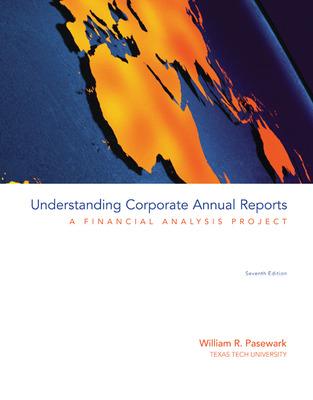Question
Mastery Problem: Financial Statement AnalysisLiquidity and Solvency MeasuresYour friend, another accountant, has bet you that with your knowledge of accounting and just the computations for
Mastery Problem: Financial Statement AnalysisLiquidity and Solvency MeasuresYour friend, another accountant, has bet you that with your knowledge of accounting and just the computations for common analytical measures, you can figure out many aspects of a company'sfinancial statements. You take the bet!Match each computation to one of the liquidity and solvency measures in the table. (Hint: Begin by looking for simple computations and identifying the amounts in those computations. Look forother measures that use those amounts.)Liquidity and Solvency Measures ComputationsWorking capital :Current ratio :Quick ratio :Accounts receivable turnover :Number of days' sales in receivables :Inventory turnover :Number of days' sales in inventory :Ratio of fixed assets to long-term liabilities :Ratio of liabilities to stockholders' equity :Times interest earned :Balance SheetUse the following balance sheet form to enter amounts you identify from the computations on the Liquidity and Solvency Measures part. You will identify other amounts for the balance sheet on the Profitability Measures part. If you have a choice of two amounts, assume the first amount in the ratio is for the end of the year. Compute any missing amounts.Balance SheetDecember 31, 20Y6AssetsCurrent assets:Cash : $823,000Marketable securitiesAccounts receivable (net)InventoryPrepaid expensesTotal current assetsLong-term investmentsProperty, plant, and equipment (net)Total assetsLiabilitiesCurrent liabilitiesLong-term liabilitiesTotal liabilitiesStockholders' EquityPreferred stock, $10 parCommon stock, $5 parRetained earningsTotal stockholders' equityTotal liabilities and stockholders' equityProfitability MeasuresMatch each computation to one of the profitability measures in the table.Profitability Measures. ComputationsAsset turnoverReturn on total assetsReturn on stockholders' equityReturn on common stockholders' equityEarnings per share on common stockReturn on total assetsReturn on stockholders' equityReturn on common stockholders' equityEarnings per share on common stockPrice-earnings ratioDividends per shareDividend yieldComparative Income StatementUse the following comparative income statement form to enter amounts you identify from the computations on the Liquidity and Solvency Measures part and on the Profitability Measures part.Compute any missing amounts and complete the horizontal analysis columns. Enter percentages as decimal amounts, rounded to one decimal place. When rounding, look only at the figure to theright of one decimal place. If

Step by Step Solution
There are 3 Steps involved in it
Step: 1

Get Instant Access to Expert-Tailored Solutions
See step-by-step solutions with expert insights and AI powered tools for academic success
Step: 2

Step: 3

Ace Your Homework with AI
Get the answers you need in no time with our AI-driven, step-by-step assistance
Get Started


